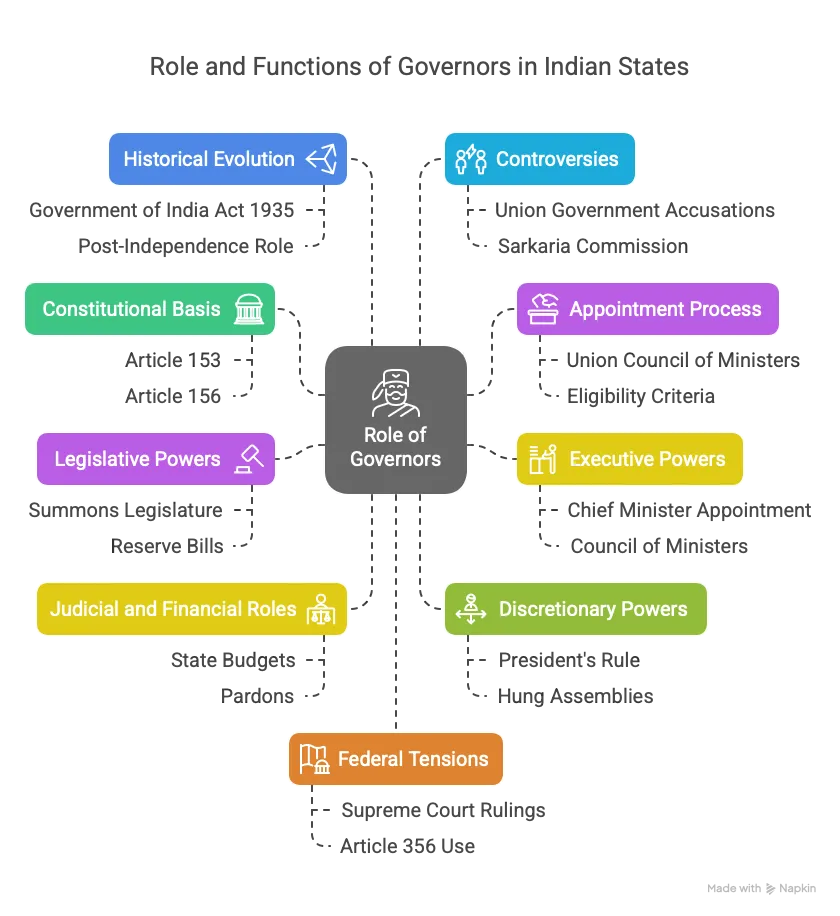UPSC
The Hindu Briefs
Role of Governors in Indian States: Constitutional Significance
Last Updated
13th April, 2025
Date Published
13th April, 2025
Share This Post With Someone

- Constitutional Basis:
- Governors are appointed under Article 153, with one Governor per state (some serve multiple states).
- Article 156 allows a five-year term, subject to the President’s pleasure.
- Appointment Process:
- Appointed by the President on the advice of the Union Council of Ministers.
- No fixed eligibility criteria, but typically senior politicians, retired bureaucrats, or judges.
- Executive Powers:
- Acts as the constitutional head of the state, exercising powers on the advice of the Council of Ministers (Article 163).
- Appoints the Chief Minister, Council of Ministers, and key officials like the Advocate General.
- Legislative Powers:
- Summons, prorogues, and dissolves the state legislature (Article 174).
- Can reserve bills for the President’s consideration or return non-money bills for reconsideration.
- Addresses the legislature and nominates one Anglo-Indian member (provision now expired).
- Judicial and Financial Roles:
- Grants pardons or reprieves for state offenses (Article 161), excluding death sentences.
- Ensures state budgets are presented; money bills require prior approval.
- Discretionary Powers:
- Acts independently in cases like dismissing a ministry lacking majority, recommending President’s Rule (Article 356), or resolving hung assemblies.
- Discretion often leads to friction with state governments.
- Historical Evolution:
- Derived from the Government of India Act, 1935, where Governors had overriding powers.
- Post-independence, the role became ceremonial, akin to the President’s, but retains significant influence in crises.
- Controversies:
- Accusations of Governors acting as Union government agents, especially in opposition-ruled states.
- Examples: Delays in bill assent, interference in state politics (e.g., Karnataka 2018, Maharashtra 2019).
- Sarkaria Commission (1988) and Punchhi Commission (2010) recommended reforms for impartiality.
- Federal Tensions:
- Conflicts arise when Governors overstep constitutional bounds, undermining state autonomy.
- Supreme Court rulings (e.g., S.R. Bommai case, 1994) limit arbitrary use of Article 356.
- Reform Suggestions:
- Proposals include fixed tenure, consultation with states for appointments, and clearer guidelines on discretion.
- Aim to balance federalism with constitutional duties.

Key Terms:
- Governor: Constitutional head of a state, appointed by the President.
- Article 153: Constitutional provision establishing the office of Governor.
- Article 356: Allows President’s Rule in states, often recommended by Governors.
- Discretionary powers: Governor’s authority to act independently in specific situations.
- Federalism: Division of powers between Union and states in India’s Constitution.
- Sarkaria Commission: Panel recommending reforms for Centre-state relations.
- President’s Rule: Central takeover of state governance during crises.
Link To The Original Article – https://www.thehindu.com/news/national/why-do-we-have-governors-in-every-state-explained/article69445628.ece